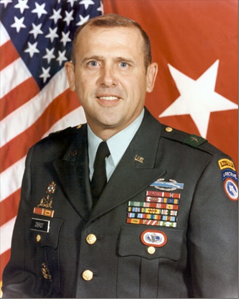Brigadier General
John G. Zierdt Jr.
 Born in
Warner-Robins, Georgia, in 1943, John Zierdt graduated from West Point in 1966. Commissioned an Infantry officer,
he served in various assignments including duty in Vietnam. He then became an Ordnance officer, attending the
Ordnance Officers Advanced Course from 1969 to 1970 and earning a Master of Science in Industrial Engineering from
Arizona State University in 1972. He next served as Chief, Systems Analysis Office, Army Laser Project at Redstone
Arsenal, Alabama where he helped develop the first tactical model of an air-defense laser and procured additional
Department of Defense funds for further Army laser research.
Born in
Warner-Robins, Georgia, in 1943, John Zierdt graduated from West Point in 1966. Commissioned an Infantry officer,
he served in various assignments including duty in Vietnam. He then became an Ordnance officer, attending the
Ordnance Officers Advanced Course from 1969 to 1970 and earning a Master of Science in Industrial Engineering from
Arizona State University in 1972. He next served as Chief, Systems Analysis Office, Army Laser Project at Redstone
Arsenal, Alabama where he helped develop the first tactical model of an air-defense laser and procured additional
Department of Defense funds for further Army laser research.
From 1975 to 1977, Zierdt commanded the 71st Ordnance Company in Hanau, Germany, and then served as Materiel Officer in the 8th Maintenance Battalion in Hanau. From 1979 to 1982, he served as a Budget Officer, first in the Department of the Army, Office of the Deputy Chief of Staff for Research, Development, and Acquisition, and then in the Office of the Chief of Staff, US Army, Program Analysis and Evaluation. He was assigned, from 1982 to 1984, as Executive Officer to the Deputy Commanding General of the Army Materiel Command. From 1984 to 1985, he commanded the 2nd Infantry Division's 702nd Maintenance Battalion in Korea. Zierdt's next assignment was as Chief of the Ordnance Branch, US Army Military Personnel Center from 1985 to 1986. He next served, from 1987 to 1988, as Chief of Program Analysis and Evaluation at Headquarters, Training and Doctrine Command, Fort Monroe, Virginia.
Zierdt took command of the 18th Airborne Corps' 46th Support Group at Fort Bragg in 1988. He deployed his 1,900 Soldiers to St. Croix, Virgin Islands, following Hurricane Hugo to provide disaster relief. He then took command of the 18th Airborne Corps' 1st Corps Support Command (COSCOM) in 1989. He soon faced the challenge of planning and providing logistics support for Operation Just Cause in Panama in 1989, a complicated, but very successful, joint-logistics operation. Zierdt then faced the even greater challenge of Operation Desert Shield/Storm. He deployed the 1st COSCOM to Saudi Arabia and watched it grow from 6,000 to 24,000 Soldiers in support of an 18th Airborne Corps that had grown to 120,000 Soldiers. During the ground campaign, the 1st COSCOM supported the Corps as it swept over 600 miles of desert in four days, flanking Iraqi forces in Kuwait.
Zierdt left the 1st COSCOM in 1991 to serve as the J-8 (Resource Management) at the Army Forces Command (FORSCOM), Fort McPherson, Georgia. He oversaw a $3.5 billion budget and the allocation of 28,000 civilian workers among 18 installations. In his final assignment as FORSCOM's J-4 (Logistics) from 1993 to 1995, he reorganized the logistics systems at FORSCOM installations, reducing the value of required on-hand inventory by 39 percent and the number of lines of supply in stock by 19 percent. He also established a redistribution center to transfer and balance supplies between installations, saving 15 percent of annual costs. Finally, he established a series of regional repair centers to revitalize FORSCOM's rebuild program. BG Zierdt retired in 1995 after 29 years of distinguished service to the Army and the Ordnance Corps.